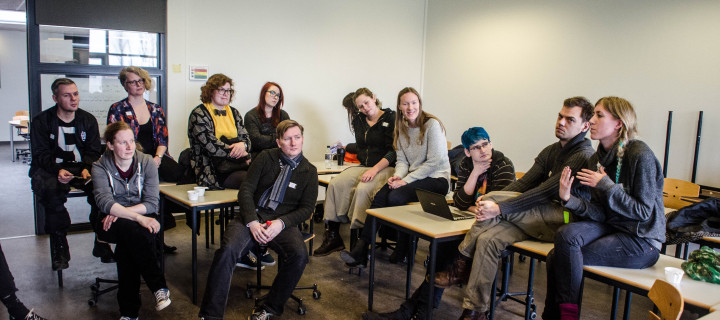Larp is traditionally participatory in nature. Fortunately, there’s been a great introspective and analytical tradition accompanying the continuing push against the ever moving boundaries of what’s possible and what’s been attempted. Yet it seems that our vocabulary has not grown at the same rate as the art form itself.
This article will attempt to cover some of the recent strides towards enriching that vocabulary. It presents the findings of several projects each exploring the nature of larp by investigating how the play and narrative experience change when mediated through computer/larp hybrids. These projects have investigated the interactive digital narrative academic literature, and have come away with a range of terms and concepts directly applicable to larp.
It is my hope that this article will both provide the community with an enriched vocabulary for conversing about our art form, and an expanded analytical toolbox for designing and researching larps.
Before jumping into the murky waters of terminology, let’s first ensure that we’re on the same riverbank. There’s been many endeavours to define role-playing, and I’d like to add my voice to the cacophony. But it’s my hope that by refining and combining the current definition attempts, we can turn the cacophony into a choir instead.
Can’t You See I’m Role-playing?
Based on my experience with the different forms of role-playing, the definitions of Hitchens & Drachen[1]Hitchens,M.,& Drachen,A.(2008).The many faces of role-playing games.International journal of role-playing,1(1),3-21., Arjoranta[2]Arjoranta, J. (2011). Defining Role-Playing Games as Language-Games. International journal of role-playing, 1(2), 3-17. and Montola[3]Montola, M., 2008.The invisible rules of role- playing.The social framework of role-playing process. International journal of role-playing, 1(1), pp.22–36, as well as the results from my thesis projects[4]Temte, B. F. (2014). I, Herosmaton? Unpublished Master Thesis, Department of Architecture, Design and Media Technology, Section of Medialogy, Aalborg University Copenhagen. Supervisors: Bruni, L.E. & Eladhari, M. [5]Temte, B. F., & Schoenau-Fog, H. (2012). Coffee tables and cryo chambers: a comparison of user experience and diegetic time between traditional and virtual environment-based roleplaying game scenarios. In Interactive Storytelling (pp. 102-113). Springer Berlin Heidelberg. [6]Temte, B. F. (2011). Project Restless Sleep – An Experimental Framework for Investigating the Change in User Experience of Roleplaying Games in Virtual Environments. Unpublished Bachelor Thesis, Department of Architecture, Design and Media Technology, Section of Medialogy, Aalborg University Copenhagen. Supervisor:
Schoenau-Fog, H., I would argue that there are a number of different processes to what we are currently calling role-playing:
Textoring (Lit: weaver): Exploring the potential story evolution possibilities, I.e. the story-space[7]The complete set of potential story evolutions for the story in its current state, and consequently manufacturing a personal, curated story-subspace instance, focused on the nodes deemed favourable to an engaging story evolution.
Auctoring (Lit: authoring, acting, originator): (Re)defining the character itself, including personality traits and background. This is both done as part of the initial character creation process, performed by either the player or an author, and at runtime by the player and possibly also the GM.
Ductoring (Lit: guiding, leading, commanding): Determining the appropriate actions/utterances for the character in the given situation. Performed at runtime, with some ductoring taking place during character creation regarding background events.
Rectoring (Lit: ruling, directing, mastering): Directing the story through the actions/utterances of the character. Only at runtime, arguably some planning during initial character creation.
Cantoring (Lit: acting, playing, poet): Portraying/acting out the character physically, including body movements, tone of voice, facial gestures etc. Only at runtime. While one could argue that cantoring may be contemplated prior to runtime, in order to best get a sense of the character’s physical mannerisms, I would label such contemplations as auctoring. However, it is quite common for role- players to explore the mental exercise of imagining their character in various situations, and so a degree of overlap is theoretically possible.
Quod-core
With these processes as a foundation, it’s now possible to formulate a new definition of Role-Playing:
A type of Pretence-Play where Participants interact, often through rules, with a diegetic world through the continuous ductoring and possibly cantoring, rectoring and auctoring, of distinct characters, thus collaboratively co-textoring an emergent, ephemeral narrative.
The core of role-playing is thus, in the presented definition, not the playing of a role per se. Rather, it’s the ductoring of the character(s) you control, the continuous process of evaluating the appropriate and relevant actions for the character and situation, that is the heart of our artform. Whether you then describe or act out the chosen action(s) is of lesser importance, and covered by the definition as well. One would argue that ductoring could also happen e.g. when you read a book or watch a movie. I completely agree, and posit that these examples are also to a large extent role-playing, the only major difference being the degree of interactivity offered by the medium.
Basing media interaction on reader- response theory, the definition also takes this into account through mentioning ‘participants interacting with’.
However, ductoring doesn’t say anything about whether you actually act upon these evaluations. You may be ductoring with/by yourself in a cupboard for 12 hours, without ever moving or saying anything. When larping, a more important concept is thus to which degree you’re acting on behalf of your character or yourself. I define this as the degree of herosproxy.
When exhibiting a low degree of herosproxy, you’re essentially playing and acting as yourself in the given situations, with little regard for your player character’s motivations and personality. Reversely, a high degree of herosproxy signifies both a large amount of ductoring, and that said ductoring is being reflected and acted upon. Therefore, herosproxy is the most relevant real-world measure of role-playing.
What IDS Brought along…
I’d now like to present some of the terminology that the interactive digital storytelling academic community has developed for better understanding and researching their, and to a large extent our, field.
Aarseth[8]Aarseth, E. (2012, May). A narrative theory of games. In Proceedings of the international conference on the foundations of digital Games (pp. 129-133). ACM. divides narrative elements into Kernels and Satellites, kernels being story elements/events which define the story, and satellites being elements/events without which the story would still be recognisable. Clearly, this distinction does not take into account the ephemerality of role-playing stories, but it still gives us terms to distinguish between primary and secondary events/elements. Likewise, one could argue that a larpwright should focus on kernels, letting the satellites happen on their own.
Figure 1: Ryan’s 9 interactive narrative structures[9]Ryan, M. L. (2001). Narrative as virtual reality. Baltimore: Johns Hopkins University Press.. Illustrations from [10]Temte,B.F.,Aabom,H.T.,Bevensee,S.H.,Boisen,K.A.D.,& Olsen,M.P.(2013).Aporia:Codename Still LakeValley – Exploring the Merge of Game-play and Narrative through Multiplayer Cooperation and Storytelling.Unpublished project report,Department of Architecture, Design and Media Technology, Section of Medialogy, Aalborg University Copenhagen. Supervisor: Bruni, L.E.. | |
Ryan[11]Ryan, M. L. (2001). Narrative as virtual reality. Baltimore: Johns Hopkins University Press. presents nine different interactive narrative structures, along with their individual characteristics, with a tenth added by myself[12]Temte, B. F. (2014). I, Herosmaton? Unpublished Master Thesis, Department of Architecture, Design and Media Technology, Section of Medialogy, Aalborg University Copenhagen. Supervisors: Bruni, L.E. & Eladhari, M., this being ‘Instigating Event with Conflict-laden Characters’. The nine original can be seen on figure 1.
I have yet to come up with a suitable illustration for Instigating Event with Conflict-laden Characters. The ten structures can work as tools for designing and framing conversations about larp structures as well.
Ryan[13]Ryan, M. L. (2008). Interactive narrative, plot types, and interpersonal relations. In Interactive Storytelling (pp. 6-13). Springer Berlin Heidelberg. also proposes two different types of immersion in interactive narratives, these being ludic and narrative immersion. She also distinguishes between spatial, temporal and emotional narrative immersion.
Additionally, Ryan suggests three distinct types of plot in interactive stories, with each plot type primarily suitable for a specific narrative immersion:
Epic: Focuses on the struggle of the individual to survive in a hostile world – Spatial Immersion
Dramatic: The evolution of a network of human relations – Emotional Immersion
Epistemic: The desire to solve a mystery – Temporal Immersion (components of which are curiosity, surprise and suspense).
We’re also given a tool for categorising player actions/utterances, where Theune, Linnsen and Alofs[14]Theune, M., Linssen, J., & Alofs, T. (2013). Acting, Playing, or Talking about the Story: An Annotation Scheme for Communication during Interactive Digital Storytelling. In Interactive Storytelling (pp. 132-143). Springer International Publishing. construct a scheme:
This works very well for categorising e.g. player utterances when analysing larp play (see[15]Temte, B. F. (2014). I, Herosmaton? Unpublished Master Thesis, Department of Architecture, Design and Media Technology, Section of Medialogy, Aalborg University Copenhagen. Supervisors: Bruni, L.E. & Eladhari, M.).
| Reference | ||||
|---|---|---|---|---|
| Perspective | Story | Game | Reality | |
| Character | CS: In-character utterances and imitations | CG: In-character references to game elements | CR:In-character references to events or objects outside play | |
| Player | PLS: Action suggestions and proposals referring to the story | PLG: Communication about game aspects | PLR: Including real-life events or objects in the game frame | |
| Person | PES: Observations about events that happened in the story | PEG: Observations about the interface, opinions about the game | PER: Communications about events or objects outside play | |
Figure 2: Theune, Linnsen and Alofs PxR annotation scheme[16]Theune, M., Linssen, J., & Alofs, T. (2013). Acting, Playing, or Talking about the Story: An Annotation Scheme for Communication during Interactive Digital Storytelling. In Interactive Storytelling (pp. 132-143). Springer International Publishing.. Illustration from[17]Temte, B. F. (2014). I, Herosmaton? Unpublished Master Thesis, Department of Architecture, Design and Media Technology, Section of Medialogy, Aalborg University Copenhagen. Supervisors: Bruni, L.E. & Eladhari, M.
Mine, My Own, My Propositions
In [18]Temte, B. F., & Schoenau-Fog, H. (2012). Coffee tables and cryo chambers: a comparison of user experience and diegetic time between traditional and virtual environment-based roleplaying game scenarios. In Interactive Storytelling (pp. 102-113). Springer Berlin Heidelberg., I define Diegetic Adherence to be the degree to which diegetic time equals real time, i.e. whether the larp is running on a 1:1 time, or e.g. features flashbacks/slow motion. This term can both be used for describing/discussing/designing larps, and for analytic purposes.
Hulk, Meet Spock
I also here propose two non-opposed play styles/attributes; Cerebral and Embodied. The distinction here is whether the player seeks out the intellectual challenge(s) or instead strives to be physically/emotionally affected by the larp/situation. Cerebral gamists thus enjoy the intellectual challenge of a mystery or tactical battle, whereas embodied gamists thrive on e.g. the adrenaline response of the battle itself. Embodied immersionists aim for becoming their character, whereas cerebral immersionists are more akin to simulationists, aiming instead for experiencing being in the diegetic world.
Dramaticists with a cerebral focus, enjoy shaping the story and influencing/ experiencing its fl ow and aesthetics, whereas embodied dramaticists instead seek the emotional response from entering the story. I do not see these terms as necessarily being directly in opposition however. Larps/situations where you’re both intellectually and emotionally engrossed are easily imagined.
Exploding the Player Character
In [19]Temte, B. F. (2014). I, Herosmaton? Unpublished Master Thesis, Department of Architecture, Design and Media Technology, Section of Medialogy, Aalborg University Copenhagen. Supervisors: Bruni, L.E. & Eladhari, M., I define the ALHFa-PAV categorisation (pronounced Alpha-Paw) as a way of dividing and discussing the components of a player character:
Avatar: Physical manifestation of person in another reality. Navigational and ludic focus in games. In larps, the avatar is ourselves.
Locus: The visual appearance of a particular avatar. How we look, with costume, makeup, expression and props.
Herosmaton: The specific contents of the person schema of a player character, including personality traits, goals, background etc.
Facies: The countenance/appearance of a particular herosmaton. How the herosmaton looks inside the imagined diegesis.
Player Character: The combined avatar, locus, herosmaton and facies, along with its more ludic characteristics, e.g. strength score, hit points etc., and the actions available to it, defined below as Ago and Vis.
Ago: The verbs available to the particular PC, such as run, jump, shoot etc.
Vis: The ludic stats associated with the PC, such as hit points, strength score etc.
It’s my hope that our community may adopt some or all of the terms, hereby easing the joint communication and understanding of the player character elements.
Picking Nits
There is little doubt that bleed as a larp term and concept is both relevant and real (for a given definition of real).
But given the pre-existing uses and meanings associated with bleed as a term outside the role-playing community, and the fact that I’m a nerd when it comes to terms/classifications, I would propose to rename the concept Flusentio (in/ex) [Lit: Flow/bleed of feelings]. Influsentio would thus be emotions, characteristics and/ or opinions flowing/bleeding from player to character, with Exflusentio denoting flowing/ bleeding from character to player.
Concerning Genres
Usually, when discussing larps, we refer to the genre as based on those of Hollywood movies. The Danish larp theorist Jacob Nielsen proposes that we instead/additionally adopt the vocabulary of the art world as a way of discussing our works and the intentions of the authors.
For instance, playing a social realism drama expressionistically will yield a very different play through than the exact same larp played abstractly, impressionistically or post-modern. Therefore, I strongly encourage you read Jacob Nielsen’s thought-provoking article on styles in larp in this book.
I hope that the usefulness and relevance of these terms are clear, and encourage further debates about and expansions of our shared vocabulary. I also hope that the term-nado I’ve just unleashed has either blown you away, or at least ruffled your feathers enough that a productive debate will ensue, at whichever decibel level you prefer.
This article was initially published in The Knudepunkt 2015 Companion Book which was edited by Charles Bo Nielsen & Claus Raasted, published by Rollespilsakademiet and released as part of documentation for the Knudepunkt 2015 conference.
Cover photo: “Participants discussing at Knutepunkt 2015” by Johannes Axner is licensed under CC BY-NC-SA 4.0.
References
| ↑1 | Hitchens,M.,& Drachen,A.(2008).The many faces of role-playing games.International journal of role-playing,1(1),3-21. |
|---|---|
| ↑2 | Arjoranta, J. (2011). Defining Role-Playing Games as Language-Games. International journal of role-playing, 1(2), 3-17. |
| ↑3 | Montola, M., 2008.The invisible rules of role- playing.The social framework of role-playing process. International journal of role-playing, 1(1), pp.22–36 |
| ↑4, ↑12, ↑15, ↑17, ↑19 | Temte, B. F. (2014). I, Herosmaton? Unpublished Master Thesis, Department of Architecture, Design and Media Technology, Section of Medialogy, Aalborg University Copenhagen. Supervisors: Bruni, L.E. & Eladhari, M. |
| ↑5, ↑18 | Temte, B. F., & Schoenau-Fog, H. (2012). Coffee tables and cryo chambers: a comparison of user experience and diegetic time between traditional and virtual environment-based roleplaying game scenarios. In Interactive Storytelling (pp. 102-113). Springer Berlin Heidelberg. |
| ↑6 | Temte, B. F. (2011). Project Restless Sleep – An Experimental Framework for Investigating the Change in User Experience of Roleplaying Games in Virtual Environments. Unpublished Bachelor Thesis, Department of Architecture, Design and Media Technology, Section of Medialogy, Aalborg University Copenhagen. Supervisor: Schoenau-Fog, H. |
| ↑7 | The complete set of potential story evolutions for the story in its current state |
| ↑8 | Aarseth, E. (2012, May). A narrative theory of games. In Proceedings of the international conference on the foundations of digital Games (pp. 129-133). ACM. |
| ↑9, ↑11 | Ryan, M. L. (2001). Narrative as virtual reality. Baltimore: Johns Hopkins University Press. |
| ↑10 | Temte,B.F.,Aabom,H.T.,Bevensee,S.H.,Boisen,K.A.D.,& Olsen,M.P.(2013).Aporia:Codename Still LakeValley – Exploring the Merge of Game-play and Narrative through Multiplayer Cooperation and Storytelling.Unpublished project report,Department of Architecture, Design and Media Technology, Section of Medialogy, Aalborg University Copenhagen. Supervisor: Bruni, L.E. |
| ↑13 | Ryan, M. L. (2008). Interactive narrative, plot types, and interpersonal relations. In Interactive Storytelling (pp. 6-13). Springer Berlin Heidelberg. |
| ↑14 | Theune, M., Linssen, J., & Alofs, T. (2013). Acting, Playing, or Talking about the Story: An Annotation Scheme for Communication during Interactive Digital Storytelling. In Interactive Storytelling (pp. 132-143). Springer International Publishing. |
| ↑16 | Theune, M., Linssen, J., & Alofs, T. (2013). Acting, Playing, or Talking about the Story: An Annotation Scheme for Communication during Interactive Digital Storytelling. In Interactive Storytelling (pp. 132-143). Springer International Publishing. |















